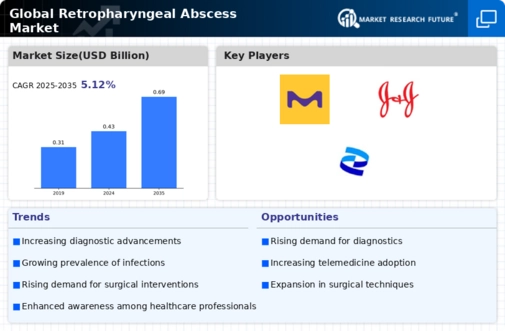Retropharyngeal Abscess Size
Retropharyngeal Abscess Market Growth Projections and Opportunities
The retropharyngeal abscess (RPA) market landscape is influenced by myriad market factors comprehended via a 3-D prism incorporating issues medical, economic and demographic. From the medical standpoint, improvements in diagnostic techniques and treatment methods are central. The increased incidence of RPA often accompanied by upper respiratory tract infections fuels demand for efficient and accessible diagnostic tools. This will probably lead to an enlargement of the market for RPA products and services as medical technologies evolve.
Economic factors have significant implications on the dynamics of the retropharyngeal abscess’s market. Healthcare spending at individual or government levels determines whether patients can access treatments or not. Accessibility of health care services, insurance coverages, general economic welfare of a region considerably influence growth in the sector. Moreover research and development investments in pharmaceuticals and medical devices will be referred to here as relevant economics committed to treating RPA boosting innovation and bettering patient outcomes.
Demographic factors also exert considerable impact on the retropharyngeal abscess market. Population age distributions especially higher prevalence among children will determine any variation that may take place in the markets concerning diagnosis or therapy options specifically suited for different ages respectively. Demographics such as some areas having more residents than others with regard to number they possess which might also mean how many people are affected from RPA who would need heath care support thus bringing out regional disparities in healthcare resources distribution patterns within regions which shall be demographically based where figures strongly indicate public education campaigns cannot be avoided by both professionals within this industry as well as all citizens who should be aware about what they should do when there are signs indicating possible occurrence of RPA.
Global and regional health policies represent a critical factor in the retropharyngeal abscess market. The regulatory ecosystem shapes approval processes of new treatments, costs associated with medical procedures, and overall market competitiveness among other aspects pricing mechanisms used during pricing these treatments also determines how well market will compete in terms of price. For instance, regulatory agencies set standards for safety and efficacy of products thus pharmaceutical and medical device landscape are shaped by them. Furthermore, significance of reimbursement policies is huge since they determine the ability of RPA patients to be able to afford and obtain necessary healthcare procedures.
The competitive landscape of the retropharyngeal abscess market is shaped by the presence and activities of key stakeholders, including pharmaceutical companies, medical device manufacturers, healthcare providers, and research institutions. This has led to mergers & acquisitions as well as industry collaborations/partnerships that have helped in shaping this market space. However such competitions are not only about already available treatments but also extend up to development of innovative approaches that fill gaps in diagnosis and management of RPA.
Consumer behavior together with customer preferences comprises a sophisticated area within the RPA market. Knowledge imparted on patients and then they become aware can determine whether they visit doctors early enough for timely interventions. Also factors like minimally invasive procedures being preferred, option for home based care services as well as overall experience provided by a healthcare facility are responsible for creating a demand specific RPA treatment."







Leave a Comment